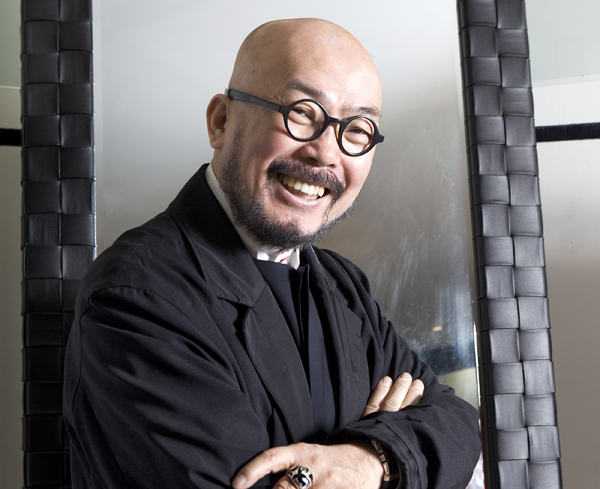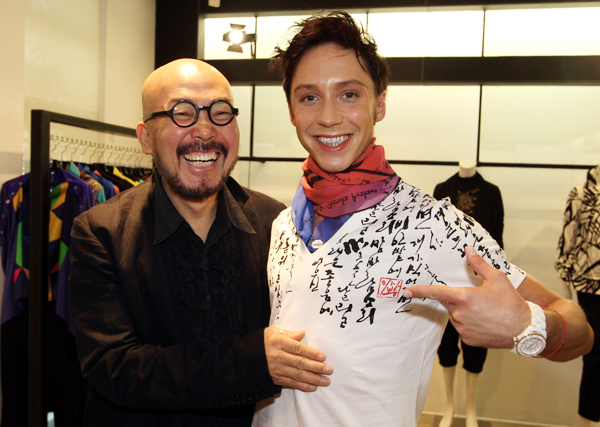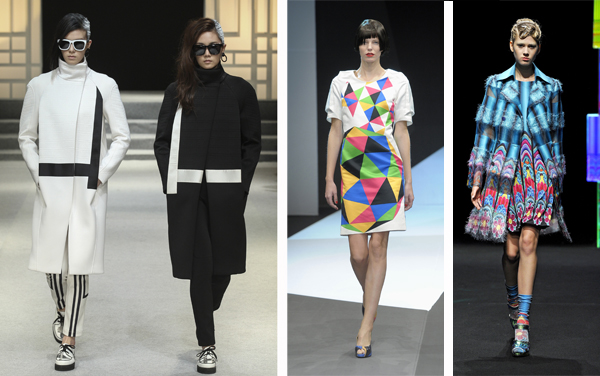Lie Sang-bong weaves stories into his clothes

Fashion designer Lie Sang-bong. By Park Sang-moon
So, as the eldest son who had a family to support, Lie wasted no time in signing up for a clothing design institute.
“I designed a variety of clothes such as jeans and business suits for a ready-made clothing company for five years and then found myself developing an urge to make my own clothes,” Lie said.
?After a five-year stint at the clothing company, Lie launched his own brand “Lie Sang Bong” in 1985 in Myeong-dong, central Seoul.
“Looking back, market vendors are the ones who made me who I am today,” said Lie as he soothed his dry cough with a warm cup of green tea after the grueling 2013 F/W Seoul Collection Blue Square, the nation’s largest biannual fashion week, which ended late last month.
“That’s because those market and street vendors were people who purchased my clothes. The next day, I could find counterfeits of mine that were put on display at street and retail shops on my way to the showroom in Myeong-dong,” added Lie with a laugh.
Although he entered the clothing business ?because he was trying to provide for his family, ?he was also serious about his career. In 1997, seeking opportunities wherever they were available, the business-savvy designer decided to go abroad when Korea was hit by the 1997-98 Asian financial crisis.
“I thought I needed a chance where I could promote and sell my clothes. So I left for the Pret-a-Porter trade show [one of the world’s largest fashion trade shows] in 1997,” wrote Lie in his recently published book, “Fashion is Passion.”

Lie is most famous for his hangul design. American figure skater Johnny Weir wears Lie’s hangul T-shirt and poses with him. [JoongAng Photo]
“Think about it. I’m doing this business more than 30 years and I have plenty of stories to tell.”
When Lie arrived in Paris, he found a national flag of the Democratic People’s Republic of Korea fluttering in front of his booth.
“All the buyers and industry people used to ask me whether I came from the South or North, but they don’t ask such questions any longer. We’ve come a long way, I believe.”
?Lie unveiled his fall and winter collection last month and detailed his three-decade career in his recently published book, but many younger Koreans know him only as the designer who appeared in an episode of the popular reality TV show “Infinite Challenge” or as the guy who makes hangul clothes.
But he’s also one of Korea’s busiest designers since Andre Kim, who died in 2010. Lie’s clothes, which are popular with people of all ages, are available in 20 stores inside Korea and in 40 stores in 15 other countries.
During a recent interview with the Korea JoongAng Daily, ?Lie talked about how Korea has come so far in fashion and how his trademark design was inspired by traditional Korean motifs from wooden window frames to dancheong, or traditional Korean decorative colorings for wooden structures.

From left; Lie’s 2013 fall and winter collection is inspired by traditional Korean window frames. Zoom-in images of the ?collection (below the models) show a button that looks like a traditional doorknob and a leather top which is based on window frame patterns; The 2009 spring and summer collection is inspired by jogakbo, or traditional Korean patchwork wrapping cloth; The 2012 spring and summer collection is inspired by dancheong, or traditional Korean decorative coloring for wooden structures. Provided by Lie Sang Bong
A. I’ve been doing collections inspired by traditional Korean objects from dancheong to jogakbo [traditional Korean patchwork wrapping cloth] to hangul. One day, I was thinking about my new collection and wooden window frames of a hanok [traditional Korean house] came into sight. I always think clothes should come with stories.
As a way to add diversity, I varied the shape of the window frame into three patterns. For example, I added colors to the frame pattern because people in the past painted the frames to prevent them from being moth-eaten.
When newlywed couples moved into their room to spend their first night together, townspeople and families used to poke a hole in the hanji [traditional Korean paper], that was stretched over the wooden window frame so that they could tease and peek at the couple. Isn’t it funny?
So I bought hanji, licked my point finger and poked, the same way people did in the past. And I developed it into a print. A majority of my employees didn’t like my ideas because they thought these varied patterns are way too distractive and loud. But I believe someone should keep bridging and mixing the old and new. We’ve been ignoring our own past for so long.
Your hangul design has come to represent Korea. Do you feel pressured to come up with something very Korean each time you work on a new collection?
My main priority has become reinterpreting traditional Korean things but it is not all about my design. It first starts with Korean elements but I eventually add my thoughts and creativity to the end products. And people also take all different things from my clothes. Foreign buyers and the press said they saw unique check patterns from my fall and winter collection. When I did a collection based on jogakbo, some took it as something traditional but some others saw [Dutch painter] Piet Mondrian from it.
The fall and winter collection started with wearable clothes but ended up with flamboyant dresses, which seemed nearly impossible to wear in everyday life. How do you find a middle ground between reality and fantasy as a designer?
It is always tricky but it is a task that designers always have to think about. I know it sounds cliche, but a majority of customers and a single customer are always the same to me. Wearable clothes in the first part of the fashion show were designed for a majority of people, but I also wanted to talk about dream and fantasy with the clothes that were shown in the latter part of the show.

I was looking for an idea as usual and then handwritten letters I got from my friends, Jang Sa-ik [singer] and Lim Ok-sang [fine art artist], attracted my attention. But none of my employees agreed with my idea. They thought it was corny to use the hangul calligraphy on clothes.
What is your typical working process when you design a line of clothes based on Korean elements such as dancheong?
There are simply not that many data and references. So I have to go there and take photos of them. It is not easy at all to start from scratch but I hope my research would be a great help to those who study fashion in the future.
It’s hard not to mention your appearance on the reality TV show “Infinite Challenge,” which made you busier than any other Korean designer. Seven celebrity hosts of the show wore your hangul clothes and strutted on the catwalk as part of their “challenges.” Seven years have passed, but a majority of Koreans still remember you as that designer from the show. Does it make you feel bittersweet? You were an established designer even before the show.
People who know me well say they feel sorry about me being referred to as the “Infinite Challenge” designer, but I really appreciate the show because it introduced me to a wide range of people from elementary school students to people in their 50s and 60s. Before the show, only a small number of people exactly knew my name, but now almost all know who I am and what my name is.
How do you want to be remembered?
If the public remembers me as the one who attempted to share our traditional Korean culture with the outer world or the one who tried to communicate with people outside the country with things that we have, that is enough for me.
PROFILE
Lie Sang-bong
-Fashion designer
-Chairman of Council of Fashion Designers of Korea
* Education:
Graduated from school of performance of Seoul Institute of the Arts in 1975
* Major achievements:
-Published “Fashion is Passion” in March
-Participated in the 2013 fall and winter collection during Paris Fashion Week in March
-Pret-a-Porter Collection (2001 to present)
-Seoul Fashion Week (1993 to present)
-Launched Lie Sang Bong in 1985
By Sung So-young [so@joongang.co.kr]










with the Korea JoongAng Daily
To write comments, please log in to one of the accounts.
Standards Board Policy (0/250자)